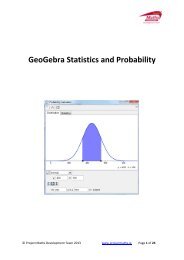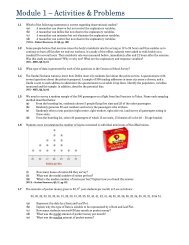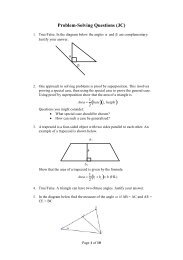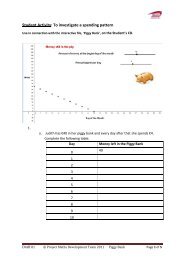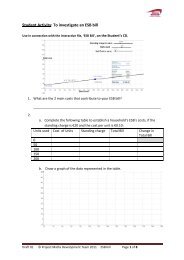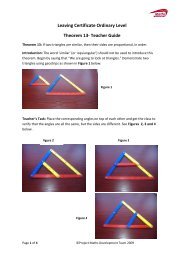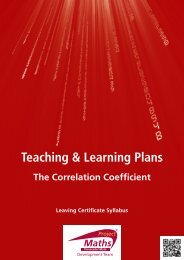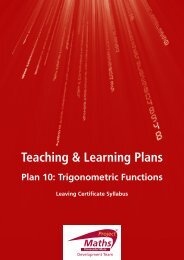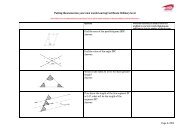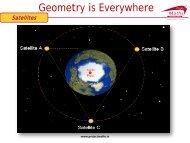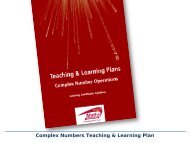Student Activities for Theorem 7 The angle opposite ... - Project Maths
Student Activities for Theorem 7 The angle opposite ... - Project Maths
Student Activities for Theorem 7 The angle opposite ... - Project Maths
Create successful ePaper yourself
Turn your PDF publications into a flip-book with our unique Google optimized e-Paper software.
Concept of “Converse” (students at the Relational level of the Van Hiele levels ofgeometric reasoning, can recognise the difference between a statement and its converse)<strong>The</strong> Converse of "If A, then B" is the assertion "If B, then A".For example, the converse of "If it is my car, then it's silver" is "If the car is silver, then its mine."From this example we see that there is no guarantee that the converse of a true statement is true.Given the statements below, fill in whether they are true/false, fill in their converses, and whetherthe converses are true or false.Statement True/False Converse True/FalseIf I live in Dublin, then I live inIreland.A tri<strong>angle</strong> is a polygon with threesidesIf an <strong>angle</strong> is a right <strong>angle</strong> then itsmeasure is 90 0 .If 3 points are collinear, then theylie on the same line.A square is figure with four right<strong>angle</strong>s.In a tri<strong>angle</strong> the <strong>angle</strong> <strong>opposite</strong> thegreater of two sides is greater thanthe <strong>angle</strong> <strong>opposite</strong> the lesser ofthe two sides.Investigating the converse of theorem 7Refer back to Pages 1 and 2, tri<strong>angle</strong>s (i), (ii), (iii), and (iv)Fill in from (i)A B Ca b cOf the two <strong>angle</strong>s, largest and smallest, which has the largest side <strong>opposite</strong> it? ________________Of the two <strong>angle</strong>s, largest and median, which has the largest side <strong>opposite</strong> it? ________________Of the two <strong>angle</strong>s, median and smallest, which has the largest side <strong>opposite</strong> it? ________________Is the greater side <strong>opposite</strong> the greater <strong>angle</strong>?Repeat this <strong>for</strong> tri<strong>angle</strong>s (ii), (iii), and (iv), on Pages 1 and 2©<strong>Project</strong> <strong>Maths</strong> Development Team 2009 Page 5
(ii) Label the <strong>angle</strong>s and sides using the letters D, E, F and d, e, f, and fill in the measurements.D E Fd e fName the largest <strong>angle</strong>: _________ _Name the longest side: _______Name the smallest <strong>angle</strong>: ________Name the shortest side: ________Name the median <strong>angle</strong>: _________Name the median side: ___________Of the two <strong>angle</strong>s, largest and smallest, which has the largest side <strong>opposite</strong>? ________________Of the two <strong>angle</strong>s, largest and median, which has the largest side <strong>opposite</strong>? ________________Of the two <strong>angle</strong>s, median and smallest, which has the largest side <strong>opposite</strong>? ________________(iii) Label the <strong>angle</strong>s and sides using the letters G, H, I and g, h, i and fill in the measurementsG H Ig h iName the largest <strong>angle</strong>: _________ _Name the longest side: _______Name the smallest <strong>angle</strong>: ________Name the shortest side: ________Name the median <strong>angle</strong>: _________Name the median side: ___________Of the two <strong>angle</strong>s, largest and smallest, which has the largest side <strong>opposite</strong> it? ________________Of the two <strong>angle</strong>s, largest and median, which has the largest side <strong>opposite</strong> it? ________________Of the two <strong>angle</strong>s, median and smallest, which has the largest side <strong>opposite</strong> it? ________________What pattern have you noticed regarding the relationship between the measures of <strong>angle</strong>s andsides in atri<strong>angle</strong>?_______________________________________________________________________________________________________________________________________________________________________________________________________________________________________________©<strong>Project</strong> <strong>Maths</strong> Development Team 2009 Page 6
Proof of the converse of <strong><strong>The</strong>orem</strong> 7 – We use proof by contradiction (students at higher level leavingcert are expected to know the meaning of this term)(Note on proof by contradiction: Assume a statement is not true and show that this assumptionleads to a contradiction – called reduction as absurdum (reduction to absurdity) in Latin.)To Prove: <strong>The</strong> side <strong>opposite</strong> the greater of two <strong>angle</strong>s in a tri<strong>angle</strong> is greaterthan the side <strong>opposite</strong> the lesser of two <strong>angle</strong>s.Given: | | |AB|Proof: Assuming that |AC| is not greater than |AB|, what are the onlyother options <strong>for</strong> the relationship between |AC| and |AB|?Option 1: _________________________Option 2: _________________________If option 1 is true draw the tri<strong>angle</strong> which would represent option 1.Hence what type of tri<strong>angle</strong> is tri<strong>angle</strong> ABC? _____________Hence what is the relationship between the |
Teacher’s board and students’ copy <strong>for</strong> the proof of theorem 7 and itsconverseConverse of theorem 7**Reference back to the director’s chair, answer to questionWhen the crossbar is positioned so that <strong>angle</strong> A islarger, the side BC of ΔABC is larger. <strong>The</strong> first chair isthe most stable because its legs are farthest apart.©<strong>Project</strong> <strong>Maths</strong> Development Team 2009 Page 8



